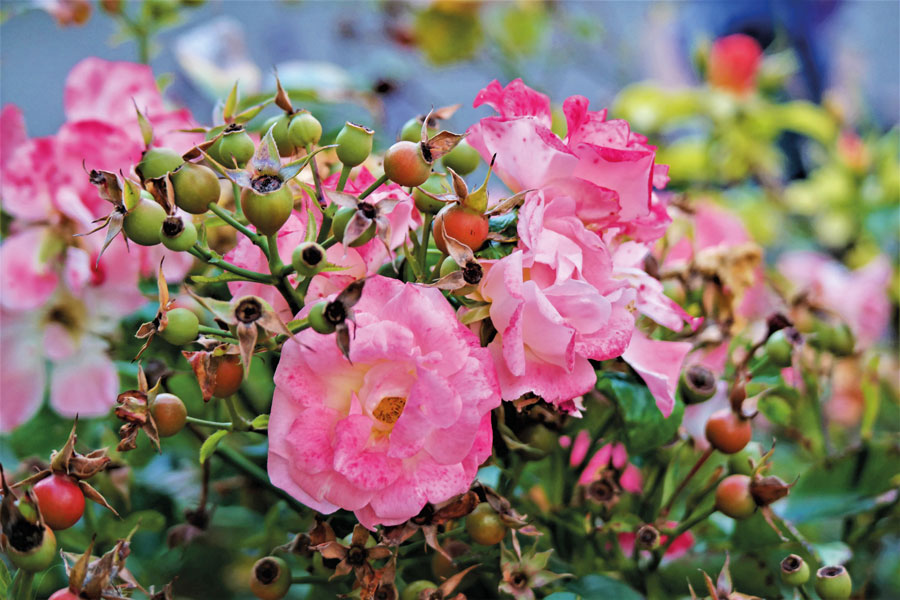March can be a tease-one minute it’s glorious sunshine the next it’s wet or frosty. Don’t be tempted to start sowing outside, it is too cold and wet. If you are keen to make a start then that’s fine providing you have a heated area that is very light, preferably a greenhouse. Quite a few gardeners that I know have a heated propagator with lights that can be placed more or less anywhere and that will start seedlings and early cuttings off very easily but beware, you will need somewhere warm and light to grow them on.
Pots and raised planters are a great way of growing flowers and vegetables if you have limited space, even in the larger garden they provide a flexible and easily maintained growing area for food crops such as salads and herbs. These can be placed on a paved area near to the kitchen for easy access. Growing in containers is easier than in border soil as the compost has all the nutrient, is free draining and no soil pests.
One of the most important things is to start with clean pots, I use a garden disinfectant, available from the garden centre or nursery and fill a large plastic trug with warm water. I remember washing clay pots in dustbins of cold water when I was an apprentice and it was most unpleasant. Choose a nice day and stand pots upside down on the path to drain. If you have timber planters it is also a good idea to give them a wash down, I have the type where you can remove the basket planters which means I can clean the whole thing and give it a coat of wood preservative at the same time. If you have planters that are filled with compost then it is a good idea to empty them out every three years and change the compost. If left, pests and diseases can build up and natural nutrients in the compost can become depleted. Each year dig out at least a third of the compost and refill with new, mixing it thoroughly with the old compost. Any removed can be either placed on the compost heap or used as a mulch around garden plants.
I mix in organic chicken manure pellets at the time I change the compost as over the coming weeks rain will disperse the nutrients amongst the compost making it available for the plants straight away. If you grow climbing plants in containers, (Sweet Peas, or Peas and Beans) check our your canes and stakes cleaning them with the same solution you use to clean the pots.

Roses are a plant that seem to drift in and out of fashion, but there is no doubt that the fragrance and colour of the blooms makes them an attractive addition to any garden. I think the best way to grow them is mixed in with other border plants and shrubs. They look quite stark and gangly when not in leaf but when in flower they can be a focal point to any display. There is still time to plant bare root roses, and they are cheaper than container grown.
Roses like to be firm in ground, and will do well in a more clay than sandy soil. Firming the plant in is the most important part of planting, use your heel near to the base of the plant and firm in well. The hole should be large enough for you to spread the roots out say 9 – 10 inches ( 22 – 25 cm) in diameter, If the soil is dry pour in half a bucket of water and allow to drain. Add either a general fertiliser or Micorrhizal bacteria at planting time, this will help them establish more quickly.
Faced with a seed catalogue or garden centre display it is easy to become over enthusiastic when buying seed. Visions of supermarket shelves crammed with fresh produce quickly entice the inexperienced gardener to go for full self sufficiency all in one go. My advice is to start small, firstly growing a few easy vegetables and salads before going for the more exotic or giants. If it’s your first venture into growing vegetables and salads, I would strongly recommend that you don’t buy any seed, and for your first year buy ready grown plants from your local Garden Centre or Nursery, the advantage being that they are already established and not sold in batches of 500!
It’s very tempting with seed to sow the whole packet and then you will be swamped with hundreds of one type and limited space for them. There is also much less choice which is good when you are starting out, the decision, which to buy is much easier and the small batches (usually about 10 – 12 in a strip) also helps you get to grips with growing little batches and spreading them out over the months ahead. Once you are confident in growing then you can expand onto raising plants from seed.
Happy Gardening
Martin
Next month, Spring lawn maintenance, Greenhouse vegetables and feeding bulbs.







